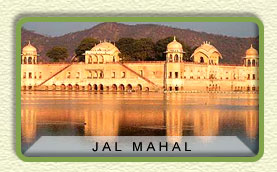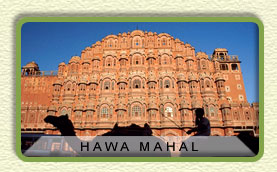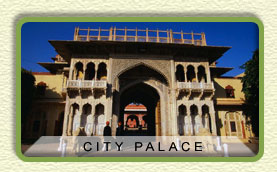 |
| YOU ARE HERE : North India Travel Packages >North Indian Tourist Destinations > Jaipur Tours Travel |
Jaipur Tours Travel
The city of Victory, Jaipur, was founded by Kachhawaha Rajput King, Maharaja Jai Singh II in 1727, who ruled from 1699 -1744. His took special
interest in the designing, planning and execution of the making of this city. This has been  divided into nine blocks, two of which were kept for the city palace and other
state buildings. The rest were for the public. The city was encircled by a city wall and seven gates opened in to the city.
divided into nine blocks, two of which were kept for the city palace and other
state buildings. The rest were for the public. The city was encircled by a city wall and seven gates opened in to the city.
The Pink City was built in only eight years. Much of it was designed by Jai himself, including the City Palace and the Jantar Mantar, a fascinating astronomical observatory with massive instruments used to predict the monsoon and identify the movements of the stars. Most impressive is a 27 metre high sundial that is accurate to the nearest two minutes. All seven gates into the old city remain, one of which leads into Johari Bazaar - the famous jewellers' market that has the best selection of precious stones in India. Jaipur is now a thriving commercial city and at the last count it was home to two million people. Although some visitors are put off by the over zealous traders, most are enthralled and enchanted by this still-welcoming city
Climate
It is hard to generalise in a country that runs from the Himalayas to the beaches of the Indian Ocean but broadly speaking October to March tend to be the most pleasant months in India, when it relatively dry and cool. In the far south the best months to visit are between January and September, while northeastern areas of India tend to be more comfortable between March and August. The deserts of Rajasthan (west of Jodhpur) and the northwestern Indian Himalayan region are at their best during the monsoon (July to September). The mountainous regions of Himachal Pradesh and Kashmir should be visited over the summer months (May to September).
Sightseeing
 divided into nine blocks, two of which were kept for the city palace and other
state buildings. The rest were for the public. The city was encircled by a city wall and seven gates opened in to the city.
divided into nine blocks, two of which were kept for the city palace and other
state buildings. The rest were for the public. The city was encircled by a city wall and seven gates opened in to the city.The Pink City was built in only eight years. Much of it was designed by Jai himself, including the City Palace and the Jantar Mantar, a fascinating astronomical observatory with massive instruments used to predict the monsoon and identify the movements of the stars. Most impressive is a 27 metre high sundial that is accurate to the nearest two minutes. All seven gates into the old city remain, one of which leads into Johari Bazaar - the famous jewellers' market that has the best selection of precious stones in India. Jaipur is now a thriving commercial city and at the last count it was home to two million people. Although some visitors are put off by the over zealous traders, most are enthralled and enchanted by this still-welcoming city
Climate
It is hard to generalise in a country that runs from the Himalayas to the beaches of the Indian Ocean but broadly speaking October to March tend to be the most pleasant months in India, when it relatively dry and cool. In the far south the best months to visit are between January and September, while northeastern areas of India tend to be more comfortable between March and August. The deserts of Rajasthan (west of Jodhpur) and the northwestern Indian Himalayan region are at their best during the monsoon (July to September). The mountainous regions of Himachal Pradesh and Kashmir should be visited over the summer months (May to September).
Sightseeing
- Hawa Mahal
Palace of the Winds, Jaipur The magnificent City Palace is in the centre of the Pink City of Jaipur, enclosed by high walls and set amidst fine gardens and courtyards. Since it was built by Jai Singh in 1728 it has been the principal residence for the Maharajas of Jaipur and the successive
rulers have each added to it. The Palace was built during the glory
days and the exhibits and interior have lost none of their
splendour; the doors and gateways preserve their flamboyant
decoration and royal retainers, clothed in turbans and full livery,
still guard the principal halls and entrances. Chandra Mahal is the
private palace of the current ruler and is approached through a
number of courtyards. Mubarak Mahal, in the first courtyard, was
once a guesthouse and is now a textile museum. There are number of
other museums displaying old costumes and uniforms, carpets,
mementos, elephant ‘saddles’ and an armoury containing a
fascinating array of fearsome and inventive weapons dating back to
the Mogul era. A beautifully carved marble gate with brass doors
leads to the second courtyard where Diwan-I-Khas, the hall of
private audiences, is found. On display here are two gigantic silver
urns used by Madho Singh II to carry water from the holy Ganges when
he travelled to London in 1902 on board an ocean liner – he was
reluctant to trust the water in the west! These are the largest
silver vessels in the world - 243 kilograms of silver was required
to cast each urn, which can contain 8,182 gallons of water.
successive
rulers have each added to it. The Palace was built during the glory
days and the exhibits and interior have lost none of their
splendour; the doors and gateways preserve their flamboyant
decoration and royal retainers, clothed in turbans and full livery,
still guard the principal halls and entrances. Chandra Mahal is the
private palace of the current ruler and is approached through a
number of courtyards. Mubarak Mahal, in the first courtyard, was
once a guesthouse and is now a textile museum. There are number of
other museums displaying old costumes and uniforms, carpets,
mementos, elephant ‘saddles’ and an armoury containing a
fascinating array of fearsome and inventive weapons dating back to
the Mogul era. A beautifully carved marble gate with brass doors
leads to the second courtyard where Diwan-I-Khas, the hall of
private audiences, is found. On display here are two gigantic silver
urns used by Madho Singh II to carry water from the holy Ganges when
he travelled to London in 1902 on board an ocean liner – he was
reluctant to trust the water in the west! These are the largest
silver vessels in the world - 243 kilograms of silver was required
to cast each urn, which can contain 8,182 gallons of water. - Amber Fort
A fascinating blend of Hindu and Muslim architecture, this fort was built by Raja Man singh on the hill side in the 16th century. The construction was started by Raja Mansingh I in 1592 and was completed by his descendant Jai singh I. While the exterior of the fort are rugged, equally bewitching are the interiors where the fusions of Hindu and Muslim architectural styles find ultimate refinement. Painted scenes of hunting and war adorn the wall with precious stones and mirrors set in to the plaster. In the foreground is the Maota Lake giving a magnificent reflection of the Fort. - Jantar Mantar
It is one of the most famous of the five observatories built by Sawai Jai singh in the 18th century. He was progressive and believed in science and technology, and was passionate about astronomy. Situated near the gates of the city palace, Jantar Mantar is the largest stone observatory in the world and has an interesting story behind its construction. Sawai Jai singh sent his emissaries all around the world before the construction began, and they returned with many manuals on astronomy containing technological information. One of these was the copy of La Hire¡¦s tables and the king ordered the observatory to be built on these tables. After the construction they realized that was 20 seconds more accurate than the table! - The City Palace
In the heart of the old city stands the majestic city palace, a former residence
of the royal family. It ahs a fine blend of Rajasthani and Mughal
architecture. The carved arches are supported by grey white marble
columns ornate with floral motifs in gold and colored stones. Two
marble elephants guard the entrance. The palace houses a museum with
an excellent collection of Rajasthani costumes and armory of Mughals
and Rajputs, including swords of different shapes and sizes. Some of
them have precious stones embelled handles in gold.The palace has an
art gallery with an excellent collection of miniature paintings,
carpets, and rare astronomical works in Arabic, Persian, Latin and
Sanskrit acquired by Sawai Jai Singh-II.
residence
of the royal family. It ahs a fine blend of Rajasthani and Mughal
architecture. The carved arches are supported by grey white marble
columns ornate with floral motifs in gold and colored stones. Two
marble elephants guard the entrance. The palace houses a museum with
an excellent collection of Rajasthani costumes and armory of Mughals
and Rajputs, including swords of different shapes and sizes. Some of
them have precious stones embelled handles in gold.The palace has an
art gallery with an excellent collection of miniature paintings,
carpets, and rare astronomical works in Arabic, Persian, Latin and
Sanskrit acquired by Sawai Jai Singh-II. - Lakshmi Narayan Temple
The temple is situated at the foot of Moti Dongrifort, a small palace of Gayatri Devi. The white marble temple is built by the Birlas and has three domes, signifying different approaches to the religion.
| Recommended Tour Itineraries |
| -->
Delhi Agra Jaipur Tours Duration : 7 Days / 6 Nights Destination Covered : Delhi - Agra - Jaipur - Delhi --> Rajasthan Wildlife Tour Duration : 8 Days / 7 Nights Destination Covered : Delhi - Agra - Jaipur - Ranthambore - Sariska --> Royal Rajasthan Tour Duration : 13 Days / 12 Nights Destination Covered : Jaipur - Nawalgarh / Mandawa - Bikaner - Jaisalmer - Jodhpur - Udaipur - Jaipur - Agra - Delhi |
| North Indian Tourist Destinations |
| Monuments in North India |
| Hill Stations in North India |
| Wildlife Attractions In Northern India |
| Guide to Forts & Palaces |
| Pilgrimage Destinations In Northern India |